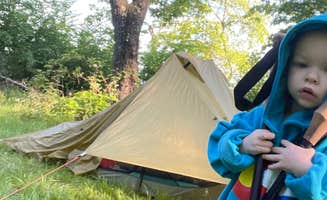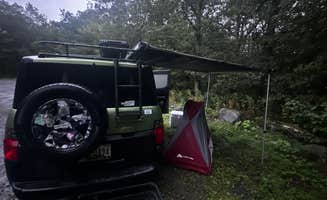Primitive camping sites near Whitehall Township, Pennsylvania offer rustic alternatives to developed campgrounds. Camping areas cluster along the Appalachian Trail corridor, with select trailhead locations providing access to backcountry experiences. Most sites sit at elevations between 1,200-1,600 feet along Blue Mountain's ridge, experiencing temperature drops 5-10 degrees cooler than valley locations during summer months.
What to do
Trail exploration from Thunder Swamp Trailhead: This gravel lot serves as a staging area for extensive hiking networks. "Trailhead parking was chill for a night. No trouble. Tons of hiking. Went down Saw Creek trail to a marsh," reports Jason R. from Thunder Swamp Trailhead. The area features multiple interconnected loops ranging from 2-8 miles.
Bird watching at higher elevations: Blue Mountain ridge provides habitat for numerous raptor species during migration seasons. Spring and fall offer optimal viewing opportunities for hawks, eagles and falcons. Early morning hours between 7-9 AM typically yield the most activity.
Photography at geological features: The rocky outcroppings along Blue Mountain provide multiple vantage points for landscape photography. Morning fog in valleys creates dramatic conditions during summer months. Tripods recommended for low-light shooting.
What campers like
Solitude and spacing: The designated backpacker sites allow campers to find their preferred level of privacy. "We stayed here during our section hike through the DWG on the AT. There's plenty of space. We camped nearer to others but there are secluded spots too," notes Katharine T. from Appalachian Trail- Designated Backpacker Campsite 2.
Overnight vehicle access: Several trailhead parking areas permit vehicle camping without extensive hiking. "It's a gravel parking lot. Plenty of shade. No one bothered me," reports Benjamin H. about Thunder Swamp Trailhead. These areas provide convenient base camps for day hiking.
Wildlife observation opportunities: The ridge ecosystem supports diverse fauna including white-tailed deer, wild turkeys, and smaller mammals. Dawn and dusk offer optimal viewing windows, with increased activity near water sources.
What you should know
Water scarcity challenges: Most sites lack reliable water sources, requiring campers to carry all needed water. "I gave the site only four stars because there's no water nearby, and the views are only mediocre," explains Renee Z. about Appalachian Trail camping. Visitors should plan for 2-3 liters per person daily in summer conditions.
Fire restrictions: The majority of dispersed sites prohibit open fires due to forest management regulations. Portable gas stoves represent the only permitted cooking method at most locations. Violation penalties can reach $500.
Limited cell coverage: Most ridge locations experience minimal to no cellular service. Coverage improves at higher elevations and exposed ridgelines but remains unreliable in valleys. Emergency communications require advance planning.
Tips for camping with families
Accessibility considerations: Most backcountry sites require hiking with full gear, making them challenging for families with young children. Bake Oven Knob offers more accessible options. "There are two large lots. You can park and sleep, or hike in and find a place for a tent," describes Dani T.
Safety preparations: Blue Mountain ridges expose campers to weather changes with limited shelter options. Families should pack extra layers regardless of season, as nighttime temperatures can drop below 60°F even in summer months.
Wildlife precautions: Proper food storage prevents unwanted animal encounters. "Well maintained w bear boxes provided," notes Katharine T. about Appalachian Trail camping. Families should establish food storage protocols before arrival at sites without infrastructure.
Tips from RVers
Parking limitations: Standard trailhead lots accommodate smaller camper vans but restrict larger recreational vehicles. "I've overnighted in my van here a bunch, no problems," reports Dani T. about Bake Oven Knob. Vehicles exceeding 20 feet in length face turning radius challenges.
Limited amenities: No dispersed sites offer hookups, dump stations or fresh water. Self-contained systems must function for entire stay durations. Plan for zero-impact camping with complete waste containment.
Overnight restrictions: Verify current regulations before overnight parking. Some trailheads permit single-night stays while others enforce day-use only policies. Delaware Water Gap National Recreation Area rangers patrol boundary areas regularly.



